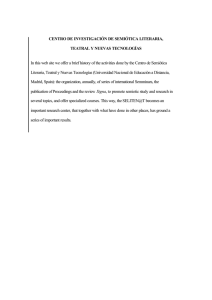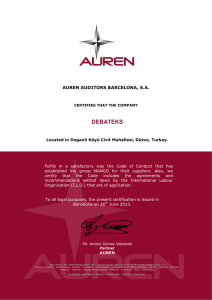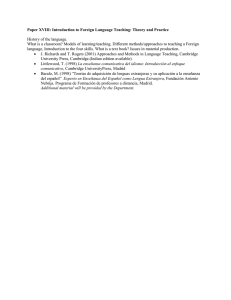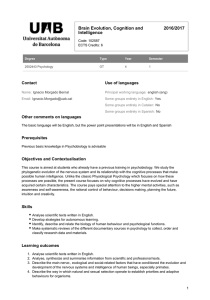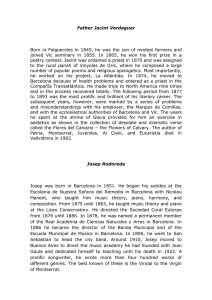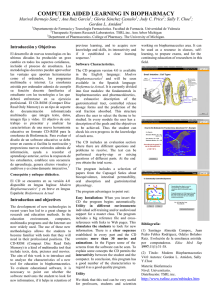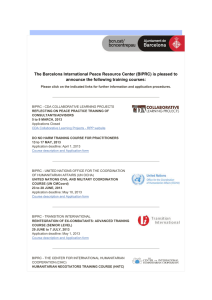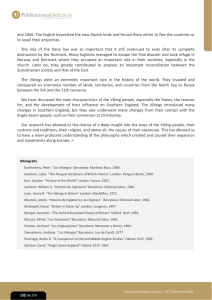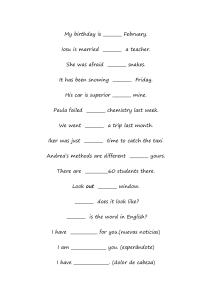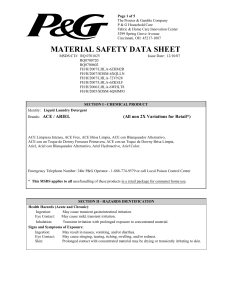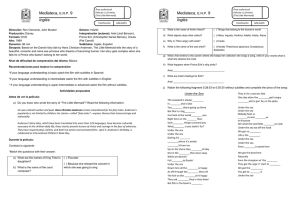Computer-Assisted Instruction
Anuncio
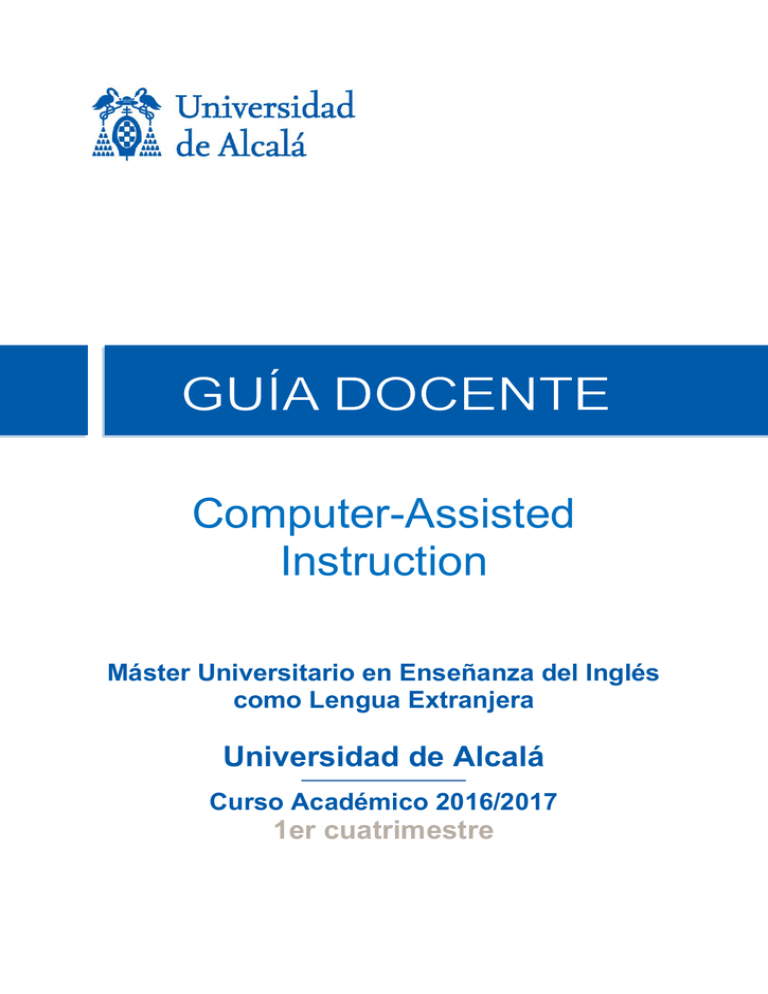
Computer-Assisted Instruction Máster Universitario en Enseñanza del Inglés como Lengua Extranjera Universidad de Alcalá Curso Académico 2016/2017 1er cuatrimestre GUÍA DOCENTE Nombre de la asignatura: Código: Computer-Assisted Instruction 200406 Departamento: Área de Conocimiento: Filología Moderna Filología inglesa Carácter: Créditos ECTS: Optativa 4 Cuatrimestre: Profesorado: 1er Isabel de la Cruz Cabanillas Correo electrónico: Idioma en el que se imparte: [email protected] Inglés 1. MODULE DESCRIPTION This course intends to explore current teaching theory and to examine ICT tools, activities and methods related to English as a Second Language teaching. Participants are expected to become familiar with some computer and online applications which they can incorporate into their own teaching. 2. AIMS Generic competences: - Use of web resources. - Problem solving. - Critical and abstract thinking. - Design of pedagogical material. - Awareness towards students’ needs and their teaching environment. Specific competences: Learners are expected to be able to - Apply the knowledge acquired in the course in order to create activities for teaching and learning English as a Second Language. - Use teaching resources which are available on the web for the teaching of English as a Second Language. - Integrate new technologies in an ordinary teaching context through a solid methodological framework. - Consider how evaluation and self-evaluation can contribute to teaching and learning processes. - Play the new roles that teachers and students adopt in the context of on-line teaching. 2 3. MODULE CONTENTS Credits Units 1. Surfing the net and its possibilities 1.1. Communicating on the net 1.2. Searching the web 1,25 2. Teaching materials 2.1. Finding and selecting the right material 2.2. Designing your own materials 1,75 3. Dictionaries and translation programs 3.1. Dictionaries 3.2. Translation programs 1 Class timetable This is an online course. Feel free to access the contents at any time using the Blackboard virtual learning environment. You can expect the course to take approximately 100 virtual hours to complete, which will include reading the material online and taking a wide assortment of interactive exercises and assignments. 4. TEACHING AND LEARNING METHODS 4.1. Student workload (100 hours) Study of theoretical contents and practical activities Reading - on the use of ICTs in the classroom - on the design of materials - on the use of dictionaries Assessment: final project and other compulsory and optional activities 50 20 30 4.2. Learning activities 3 The course will deal with both theoretical and practical contents, but most attention will be given to the latter. On the one hand, the learning modules focus on selected reading materials. On the other, the course deals with practical activities which give students an opportunity to get familiar with the use of new technologies for teaching English as a Second Language. One of the basic objectives for this course is to provide students with ideas about ways in which new technologies can be integrated into the classroom. Thus, students enrolled in the course will be asked to reflect about their own teaching practice and to prepare e-learning materials which can be useful for their own students. 5. ASSESSMENT Assessment criteria: The contents, as well as most of the assigned readings and some titles in the bibliography are written in English. Therefore, students who take this course are expected to be proficient in the English language in order to follow the course contents and complete the course assignments satisfactorily. By the end of the course, students are expected to be able to: - Demonstrate the acquisition of the main theoretical and practical contents of the subject. - Apply the contents to practical activities. - Be able to formulate opinions, critical judgements and reflections. - Incorporate original ideas and approaches. Assessment and marking procedures: The assessment of the programme will be based on a combination of participation in the virtual classroom, written assignments and a final paper. In order to assess students we will take into account: - One final project: 40% Several compulsory activities to be handed in: 40% Submitted non-compulsory activities, including discussion groups: 20% Plagiarism will not be tolerated. Those students who commit plagiarism in any of the activities mentioned above will get a fail mark in the corresponding activity. 6. BIBLIOGRAPHY Beatty, K. (2003). Teaching and Researching Computer-Assisted Language Learning. Harlow: Pearson Education Limited. 4 Browner, S., S. Pulsford & R. Sears (2000). Literature and the Internet. A Guide for Students, Teachers, and Scholars. New York/London: Garland Publishing. Cal, M., Nuñez, P. & I. M. Palacios (2005). Nuevas tecnologías en Lingüística, Traducción y Enseñanza de Lenguas. Santiago de Compostela: Universidad de Santiago de Compostela. Castaño, C., I. Maiz, G. Palacio & J. D. Villarroel (2008). Prácticas Educativas en Entornos Web 2.0. Madrid: Editorial Síntesis. Chapelle, C.A. (2001). Computer Applications in Second Language Acquisition. Cambridge: Cambridge University Press. De la Cruz, I. & C. Tejedor (2003). Las nuevas tecnologías en la enseñanza de lengua inglesa: recursos y aplicaciones. Alcalá de Henares: Universidad de Alcalá. Dudeney, G. (2000). The Internet and the Language Classroom. A Practical Guide for Teachers. Cambridge: Cambridge University Press. Dudeney, G. & N. Hockly (2007). How to Teach English with Technology. Harlow: Pearson Education Limited. Gitsaki, C. & R. P. Taylor (2000). Internet English. Oxford: Oxford University Press. García Aretio, L. (2002). La educación a distancia. Barcelona: Ariel. Moreno, F. & M. Bailly-Baillière (2002). Diseño instructivo de la formación on-line. Barcelona: Ariel. Reparaz, C., A. Sobrino & J. I. Mir (2000). La integración curricular de las nuevas tecnologías. Barcelona: Ariel. Mir, J. I., C. Reparaz & A. Sobrino (2003). La formación en Internet. Un modelo de curso on-line. Barcelona: Ariel. Sperling, D. (1999). Dave Sperling’s Internet Activity Workbook. New York: Prentice Hall. Teeler, D. & P. Gray (2000). How to Use the Internet in ELT. Harlow: Longman. Windeatt, S., D. Hardisty & D. Eastment (2000). The Internet. Oxford: Oxford University Press. Web pages - Technological Education Group of the University of the Balearic Islands http://gte.uib.es/ - Technological Education Group of the University of the Seville http://tecnologiaedu.us.es/ - Society for the Development of Educational Technology and New Tecnhologies applied to Education http://www.edutec.es/ 5
